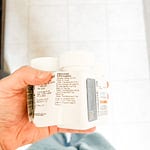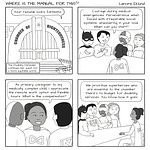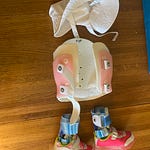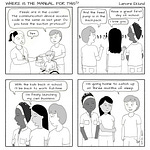The second Sunday of every month Medical Motherhood publishes Where Is the Manual for This?!, an editorial cartoon by Lenore Eklund.
There just is no substitute for: “Been there. Done that.” Yes, medical professionals and social workers have their areas of expertise and can unlock access to specialized supports. But some days you just need someone who has actually gone through it themselves, rather than read a book about it, you know? I have learned so much from my community of medical moms (and dads!) and know that my children are far better off for it.
What’s something that you’ve learned from other parents rather than professionals?
Medical Motherhood’s news round up
Snippets of news and opinion from outlets around the world. Click the links for the full story.
• From The New York Times: “Strife in the Schools: Education Dept. Logs Record Number of Discrimination Complaints”
Officials say the complaints — most alleging discrimination based on disability, race or sex — reflect grievances that amassed during the worst public health crisis in a century and the most divisive civil rights climate in decades. The complaints were logged as schools struggled to recover from pandemic-related closures, and add to the declining test scores and growing mental health challenges that display the fragility in large parts of the country’s education system.
Catherine Lhamon, the assistant secretary for civil rights, said the jump in the number of complaints, which have not yet been made public but will be reflected in the office’s annual report in the coming months, is both encouraging and sobering.
“It reflects the confidence in the Office for Civil Rights as a place to seek redress,” Ms. Lhamon said. “At the same time, the scope and volume of harm that we’re asking our babies to navigate is astronomical.”
[…]The majority of complaints in the past year, as in previous years, allege discrimination against students with disabilities — a population whose plight became more visible during the pandemic when schools drew federal scrutiny for failing to serve such students during school closures.
• From The Imprint: “Justice Department Slams Alaska for Over-Institutionalizing Youth with Disabilities”
The U.S. Department of Justice has found that Alaska’s use of residential treatment for youth with behavioral health challenges likely violates the Americans with Disabilities Act by unnecessarily segregating them from society.
If the state does not reduce its reliance on institutional care for these young people, they are at risk of a federal lawsuit to bring them into compliance with the law, department officials warned.
“Each year, hundreds of children, including Alaska Native children in significant number are isolated in institutional settings often far from their communities,” Assistant Attorney General Kristen Clarke of the department’s Civil Rights Division said in a press release. “Most of these children could remain in family homes if provided appropriate community-based services.” Clarke said her division “looks forward to working with Alaska” to bring the state into compliance with federal law, and to “prevent the unnecessary institutionalization of children.”
In a report released last month, the department stated that while community-based behavioral health interventions – including intensive case management, crisis services, home-based family treatment and others — are permitted under Alaska’s Medicaid program, they are not readily available throughout the state, with a particular dearth in rural areas. This leaves the state’s system of care for struggling children and teens “heavily biased toward institutions,” with Alaska Native youth at an increased risk of such placements.
• From The New York Times (Opinion): “Why Saving Kids is Bad Business in America”
(Trigger warning for the video at the link: It shows a 7-month-old in respiratory distress and several scenes from inside children’s hospitals. It was hard for me to watch. But it is a deeply important video for those who might not be aware of the crisis in American pediatrics and what can be done to change course.)
From the article accompanying the video:
Profit-driven management has eroded pediatric health care in America. Health care providers make more money treating adults than they do children. As a result, the number of hospitals offering pediatric care has decreased dramatically over the past two decades.
• From Oregon Public Broadcasting: “Students with disabilities face setbacks, safety risks as Oregon special education systems struggle”
[…]Entire systems of special education are fraying, as teachers, administrators and support staff try to stretch limited resources to meet intense needs.
Schools are as close to resembling pre-pandemic operations as they’ve been since March 2020. But in special education, schools are falling far short of full support and staffing. That leaves students in special education physically at risk and academically unserved — even though they are among the student groups in greatest need after more than two school years of pandemic disruptions.
National Assessment of Educational Progress, or NAEP, scores, showed the gap between students with disabilities and other students remains wide in math, with smaller gaps in reading.
[…Mom Sara] Schultz said her son was repeatedly restrained and sometimes would spend hours watching TV shows on his iPad at the last two schools. Schultz said her son would run around the school, or curse at teachers. His behavior at home changed too.
Keith wasn’t enjoying school anymore, or learning, his mom said.
“He said, ‘all days are bad days now,’ and he also was saying stuff like, ‘I’m a stupid kid, all the bad things people think about me are true,’” Schultz recalled.
Keith shut down, Schultz said. She decided to homeschool him, where she said his communication returned and his behavior improved. […]
“I just wanted my kid to get taken care of and be able to be in school,” Schultz said. “And it’s sad now because he’s at home, and he likes kids, and I hate that he’s not going. I don’t know how long it will take for him to feel safe and trust adults.”
Medical Motherhood brings you quality news and information each Sunday for raising disabled and neurodivergent children. Get it delivered to your inbox each week or give a gift subscription. Subscriptions are free, with optional tiers of support. Thank you to our paid subscribers!
Follow Medical Motherhood on Facebook, Twitter, TikTok, Instagram or Pinterest. The podcast is also available in your feeds on Spotify and Apple Podcasts. Visit the Medical Motherhood merchandise store.
Do you have a story to share or an injustice that needs investigation? Tell me about it and it may become a future issue.













